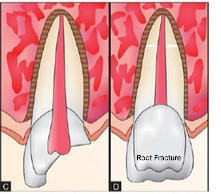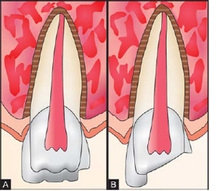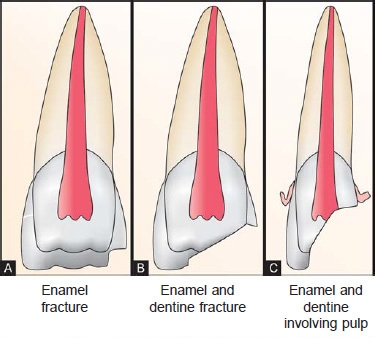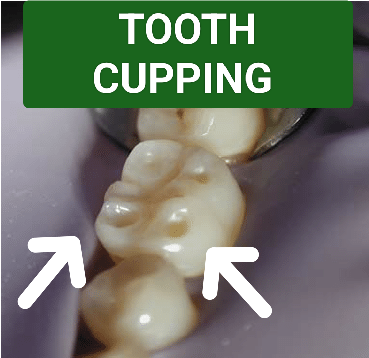A Cracked tooth is a tooth that has been broken or fractured. A tooth can become fractured due to a variety of causes including trauma to the mouth, biting down on hard objects, tooth decay, or weakened enamel. Depending on the severity of the fracture, treatment may involve bonding, dental crowns, or even tooth extraction if the tooth is severely damaged.
CLASSIFICATION OF FRACTURED TEETH
Fractured teeth can be classified into several categories based on the location, extent, and severity of the fracture. The different types of fractures include:
1. Craze lines: These are small cracks in the enamel that do not extend into the dentin or pulp.
2. Enamel fractures: These are partial or full-thickness fractures of the enamel.
3. Uncomplicated fractures: These affect only the enamel and dentin but do not reach the pulp.
4. Complicated fractures: Also known as a root fracture, this occurs when the fracture extends below the gum line and into the root of the tooth.
5. Vertical fractures: This involves a crack that runs vertically from the chewing surface of the tooth down towards the root.
6. Split tooth: This type of fracture arises when the tooth is split into separate segments, due to vertical crack extension into the root.
7. Tooth displacement: This is where the tooth has been pushed out of its correct position due to the impact of a blow, which can simultaneously result in one or many fractures.
8. Crown-root fracture – This occurs when a tooth is split horizontally, affecting the surface of both the crown and root.
The classification of a fractured tooth is based on the extent of the damage and helps to determine the most appropriate course of treatment.
ELLIS CLASSIFICATION
Ellis classification is a system used to classify dental fractures based on their severity, location and likelihood to involve the dental pulp. It is commonly used to describe fractures of anterior teeth. The Ellis classification system includes three types:

1. Ellis Class I:
This type of fracture involves only the enamel of the tooth, which is the hard white outer layer. The dentin and pulp layer below the enamel are not affected.
2. Ellis Class II:
The fracture extends into the dentin, which is the softer inner layer of the tooth, but the pulp remains intact. The tooth may be sensitive to pressure and temperature changes and will require evaluation by a dentist.
3. Ellis Class III:
This type of fracture goes all the way through the enamel, dentin, and into the pulp, which is the innermost layer of the tooth that contains blood vessels and nerves. The tooth may be very painful and requires immediate dental treatment.
In summary, Ellis classification divides dental fractures into three categories based on their severity, and helps to determine the most appropriate treatment for each case.
CAUSES OF CRACKED TOOTH
Fractured teeth can occur due to a variety of factors, both traumatic and non-traumatic. Some common causes of fracture include:
1. Trauma: Accidents involving impact or trauma to the face or mouth, such as falls, sports injuries or car accidents can result in fractured teeth.
2. Chewing hard foods or objects: Hard candies, ice, pencils, and other hard objects can cause chips or cracks in the teeth while chewing.
3. Bruxism: Habitual grinding or clenching of teeth can cause significant damage to the teeth over time, leading to fractures.
4. Tooth decay: Decay weakens the tooth structure, making it more susceptible to fracture.
5. Weakened enamel: Enamel, the hard outer layer of the tooth, can become weakened and brittle due to excessive acid exposure from various sources.
6. Large fillings: Teeth with large fillings may be more prone to fracture due to the weakened structure of the remaining tooth.
7. Lack of regular dental care and maintenance: Poor oral hygiene, inadequate dental care and lack of dental checkups can lead to tooth decay, gum disease and other problems that can cause teeth to weaken and fracture easily.
It is important to take proactive measures to protect the teeth from damage and maintain proper oral hygiene to prevent or minimize the risk of tooth fractures.
SYMPTOMS OF CRACKED TOOTH
Fractured teeth can cause a range of symptoms, depending on the location, extent, and severity of the fracture. Some common symptoms may include:
1. Pain when chewing or biting.
2. Sensitivity to hot or cold temperatures.
3. Swollen or irritated gums around the affected tooth.
4. Inflammation or abscess formation in the tooth or gum.
5. Chips or cracks visible on the tooth surface.
6. Discoloration of the tooth or surrounding gum tissue.
7. A loose or shifting tooth.
8. Soft tissue laceration or wound around the mouth, lips or tongue.
9. Blood around the affected tooth.
If you experience any of the above symptoms, it is essential to seek prompt dental care to prevent further damage or infection. Dental treatment options for a fractured tooth will depend on the extent of the fracture and may range from simple bonding or cosmetic repair to root canal therapy and tooth extraction.


FIRST-AID FOR FRACTURED TOOTH
If you sustain a fractured tooth, it is important to seek dental care as soon as possible, but there are also some first aid measures you can take to ease the pain and protect the tooth until you can get to a dentist. Here are some immediate first aid steps you can take for a fractured tooth:
1. Rinse with warm saltwater: Rinse your mouth with warm saltwater to reduce swelling and prevent infection.
2. Control bleeding: If the fracture causes bleeding, use a sterile gauze or clean cloth to apply gentle pressure to the area until the bleeding stops.
3. Apply ice pack: Apply a cold compress or ice pack to the outside of the mouth near the affected tooth to reduce swelling and pain.
4. Take pain medication: Over-the-counter pain medication such as ibuprofen or acetaminophen can help relieve pain and discomfort.
5. Cover the tooth: If the tooth is sharp or jagged, cover it with dental wax or an orthodontic band to protect your mouth and tongue from injury.
6. Avoid hard or crunchy foods: Stick to soft foods and avoid chewing on the side of the mouth where the fracture occurred.
7. See a dentist: Make an appointment with a dentist as soon as possible to evaluate and treat the fractured tooth before complications set in.
Remember that these first aid measures are not a substitute for dental care and should only be taken as a temporary relief while seeking professional help.
TREATMENT OF CRACKED TOOTH
The treatment options for fractured teeth depend on the classification and type of fracture. Here are some common treatment options based on the fracture:
1. Craze lines:
These are superficial fractures that do not require treatment but may need cosmetic treatment, such as teeth whitening or bonding.
2. Enamel fractures:
These are minor fractures that usually do not need active treatment. If the fracture affects the appearance of the teeth, cosmetic dental treatments with bonding or veneers may be recommended.
3. Simple crown fractures:
These occur below the gum line, are deeper than enamel fractures and involve the dentin (the middle layer of the tooth). Treatment may involve a dental restoration such as a crown, bonding or veneers.
4. Complex crown fractures:
These fractures occur below the gum line and involve the pulp(the innermost layer of the tooth) and nerve tissues. Treatment may involve a root canal followed by a crown for structural support.
5. Split tooth fractures:
These occur longitudinally to the tooth root. Treatment may involve extraction in some cases, but if the root is still salvageable, a root canal followed by a crown is another option.
6. Vertical root fractures:
These are fractures that extend from the root to the crown. Treatment options depend on the extent of the fracture, but in most cases, extraction is the only option.
7. Cusp fractures:
These are fractures in the pointed parts of the tooth. If the fracture affects the pulp, a root canal will be necessary, followed by a restoration such as bonding or a crown.
It is essential to see a dentist as soon as possible if you suspect that you have a fractured tooth as prompt treatment leads to better outcomes, and in some cases, may save the tooth.
RELATED ARTICLE : HOW TO FIX A BROKEN TOOTH?
CONCLUSION
Fractured teeth are a common dental problem that can cause discomfort and affect the appearance of your teeth. The causes of tooth fractures can range from traumatic injuries to dental decay and weakened enamel. The treatment options for fractured teeth vary depending on the extent and classification of the fracture and may involve dental restorations, root canals, extractions, or cosmetic treatments. Prompt treatment is essential to prevent further damage, preserve the tooth, and alleviate pain. If you experience a fractured tooth, seek dental care as soon as possible and follow the recommended treatment plan to ensure a successful outcome. Maintain good oral hygiene and take proactive measures to protect your teeth from injury to prevent potential tooth fractures from occurring.
FAQs
1. What are the common causes of tooth fractures?
Tooth fractures can be caused by various factors, including traumatic injuries to the mouth, biting on hard objects, dental decay, weakened enamel, extreme temperature changes, and wear and tear due to aging.
2. How can I prevent tooth fractures?
You can prevent tooth fractures by maintaining proper oral hygiene practices, avoiding hard and crunchy foods, wearing protective equipment while playing sports, and visiting your dentist regularly for check-ups and cleanings.
3. Is a cracked tooth an emergency?
It depends on the severity and extent of the fracture. If you experience severe pain, swelling, or bleeding, seek emergency dental care. In some cases, prompt treatment may prevent further damage to the tooth and prevent it from being extracted.
4. What happens if a cracked tooth is left untreated?
If left untreated, a fractured tooth can cause pain, sensitivity, dental abscesses, and further damage to the tooth and surrounding tissues. In some cases, an untreated fracture may require more extensive and expensive dental treatments, including root canal therapy or extraction.
5. Can tooth fractures be treated with cosmetic dentistry?
Yes, minor tooth fractures can often be treated with cosmetic dentistry procedures such as bonding, veneers, or crowns to restore the appearance and function of the tooth. However, more extensive fractures require dental restorations and root canal therapy to preserve the tooth.



